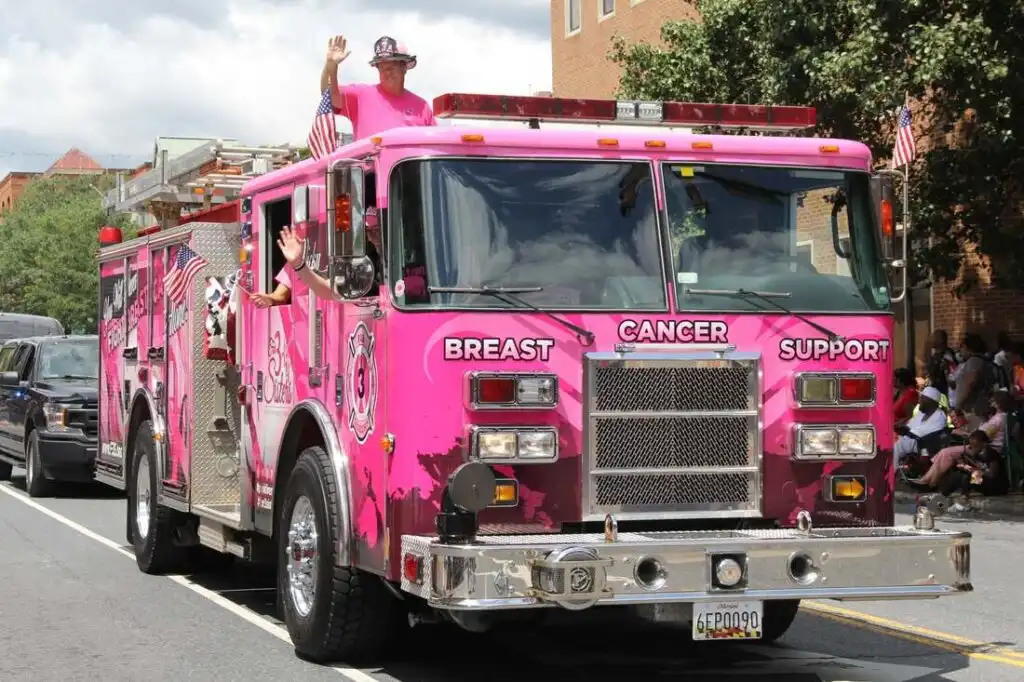Breast cancer is a disease that affects millions of lives every year, not only impacting the individuals diagnosed but also their families, friends, and communities. In the fight against breast cancer, many groups and organizations are stepping up to support patients, raise awareness, and drive research. One group that is making an incredible difference is Pink Fire Truck.
What makes Pink Fire Truck unique is its connection to first responders, particularly firefighters. While first responders are traditionally known for their heroic efforts in saving lives at the scene of emergencies, Pink Fire Truck has leveraged this profession’s community trust and respect to promote breast cancer awareness. This partnership is bridging a crucial gap between emergency services and the fight against breast cancer, creating a powerful force for change.
In this blog, we will explore how Pink Fire Truck is bringing together first responders and breast cancer awareness to make a lasting impact on both communities and individuals affected by the disease.
1. The Symbolism of the Pink Fire Truck
The pink fire truck is the cornerstone of Pink Fire Truck’s mission, acting as both a literal and symbolic vehicle for raising awareness about breast cancer. This iconic truck, which is used by first responders, is wrapped in pink and travels across communities, spreading the message of early detection, prevention, and support.
Why it matters:
-
High Visibility: The pink fire truck’s striking appearance captures attention, making it a unique and powerful symbol for breast cancer awareness.
-
Connection to Firefighters: The use of a fire truck ties the cause directly to first responders, a group known for their bravery, compassion, and commitment to serving the public. It also helps establish a clear connection between the cause and the people who risk their lives daily to protect others.
Example: The truck participates in community events such as fundraisers, parades, and health fairs, giving survivors, their families, and first responders a chance to come together to share stories, offer support, and raise awareness.
2. Raising Awareness Through First Responders
First responders, particularly firefighters, play a vital role in spreading breast cancer awareness within their communities. Firefighters are not only trusted figures in emergency situations but also respected members of the community, making them ideal advocates for promoting health education and raising awareness about breast cancer.
How they contribute:
-
Wearing Pink: Fire departments often participate in Pink Fire Truck campaigns by wearing pink uniforms or pink badges during certain times of the year, such as Breast Cancer Awareness Month. This visible support is a powerful way to show solidarity and remind the community about the importance of breast cancer screenings.
-
Promoting Early Detection: Firefighters and first responders take part in health seminars and screening events, where they provide crucial information about early detection and encourage others to undergo regular mammograms and self-examinations.
Tip: Look for events where local fire departments and Pink Fire Truck collaborate to offer free breast cancer screenings and educational resources.
3. Support for Breast Cancer Survivors
Pink Fire Truck doesn’t just raise awareness; it’s deeply committed to supporting breast cancer survivors and their families. Many first responders, as well as the community at large, offer emotional support and practical assistance, creating an environment where survivors can share their experiences and find strength in each other.
How Pink Fire Truck makes a difference:
-
Survivor Support Groups: Through their partnerships with first responders, Pink Fire Truck helps connect breast cancer survivors with one another through support groups. These groups are places where individuals can share their journeys, find comfort, and receive guidance on navigating the emotional and physical challenges of recovery.
-
Community Events: Pink Fire Truck hosts survivor celebrations and appreciation events where first responders show their support, celebrate survivors’ strength, and offer emotional encouragement.
Example: First responders, including firefighters, often serve as honorary guests at fundraisers or awareness events where survivors are celebrated, and funds are raised for future research and support.
4. Fundraising and Financial Support for Research
Breast cancer research needs continuous funding to advance treatments, improve detection methods, and eventually find a cure. Pink Fire Truck partners with first responders to host fundraising events, making sure that every dollar raised goes toward supporting research and financial aid for those affected by breast cancer.
How fundraising works:
-
Charity Events: Pink Fire Truck and first responders collaborate to organize charity runs, silent auctions, and community gatherings, with all proceeds going toward breast cancer research and financial assistance for survivors who may struggle with medical costs.
-
Awareness Campaigns: Throughout the year, Pink Fire Truck uses its platform to promote awareness campaigns, calling on community members and first responders to donate and fundraise for breast cancer research.
Tip: Participate in a Pink Fire Truck fundraiser or donate directly to help support vital research and aid for those currently battling breast cancer.
5. Creating Stronger Community Connections
The partnership between Pink Fire Truck and first responders fosters a strong sense of community. It allows for a deeper level of engagement and connection between individuals affected by breast cancer and those who are on the frontlines of emergency care.
Why it matters:
-
Increased Trust and Advocacy: First responders are trusted figures, and when they advocate for a cause, the community is more likely to pay attention. This helps increase participation in awareness campaigns, fundraising efforts, and early detection initiatives.
-
Unified Efforts: The combination of first responders’ professional credibility with Pink Fire Truck’s mission creates a unified front in the fight against breast cancer, helping to break down barriers and spread important messages to a wider audience.
Example: Fire departments hosting Pink Fire Truck days with activities, fundraising booths, and survivor stories not only raise funds but create lasting bonds within the community.
6. Promoting Firefighter Health and Breast Cancer Awareness
Many firefighters face an increased risk of certain cancers due to their work environment, and breast cancer awareness is a critical part of their overall health education. By participating in breast cancer initiatives, firefighters also help promote general health awareness within their own ranks.
How it benefits firefighters:
-
Cancer Prevention: Pink Fire Truck works to raise awareness about the importance of regular screenings not only for the public but also for firefighters, encouraging early detection of all types of cancer.
-
Wellness Programs: Fire departments often use these events to promote wellness programs and preventive health practices for their staff, ensuring that both their work environment and their health are safeguarded.
Tip: Firefighters can participate in Pink Fire Truck wellness initiatives to learn more about how to protect their own health and support those in their communities affected by breast cancer.
Conclusion
The collaboration between Pink Fire Truck and first responders is a shining example of how communities can come together to fight against breast cancer. Through education, fundraising, emotional support, and the power of visibility, Pink Fire Truck is making a significant impact on both breast cancer awareness and the overall health of first responders.
By leveraging the power of firefighters and first responders, Pink Fire Truck is building a bridge between two important forces—community health advocacy and firefighter wellness—creating a united front in the battle against breast cancer.

